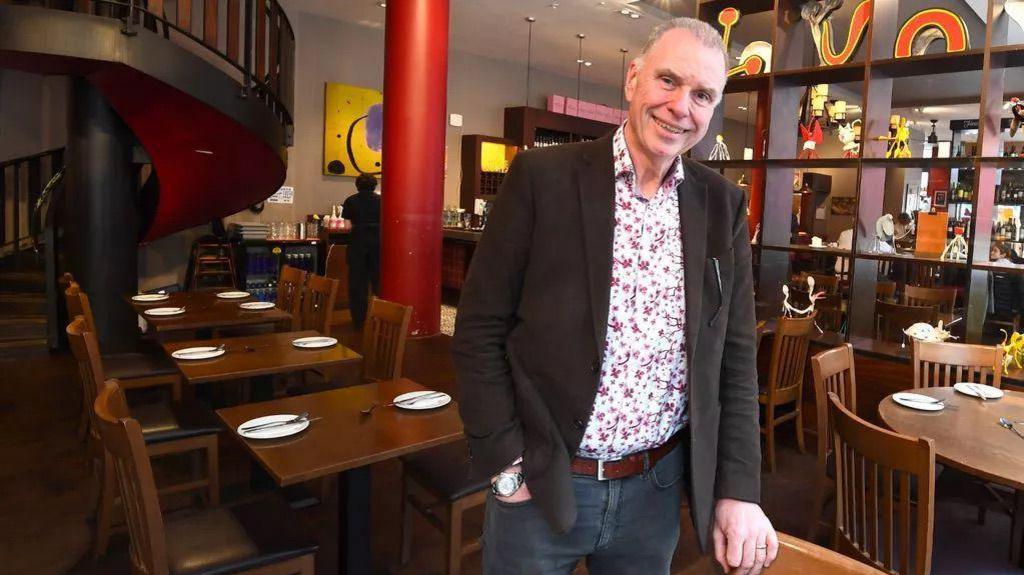UK jobs market weakens as unemployment rate rises

- Published
The UK jobs market has continued to weaken, making the prospect of an interest rate cut next month even more likely, analysts say.
The annual rate of pay growth in the three months between March and May slowed to 5%, according to the Office for National Statistics (ONS).
The unemployment rate has risen to 4.7%, its highest in four years, while the number of job vacancies has now been falling continuously for three years.
The government said "we need to go further" to improve the economy, while the Conservatives said the unemployment rise was a "disgrace".
Earlier this week, in an interview with the Times, the Bank of England governor Andrew Bailey indicated there could be larger cuts to interest rates if the jobs market showed signs of slowing down.
Yael Selfin, chief economist at KPMG UK, said the "slowing pay growth opens the door for an interest rate cut in August".
The Bank is widely expected to cut rates from 4.25% to 4% at its next meeting, though some say it would be unwise to encourage spending while inflation is still rising.
Many analysts have said that April's rise in employer National Insurance contributions (NICs) has discouraged firms from hiring.
While the unemployment rate has risen, the ONS has said the figure needs to be treated with caution due to problems with how the data is collected.
'We're managing by the skin of our teeth'

Peter Kinsella says he is more cautious about hiring staff for his restaurant
Peter Kinsella runs two Spanish restaurants in Liverpool and says this is the toughest period for the business since the financial crisis in 2008.
He says the increase in employer NICs has "really impacted our recruitment".
Mr Kinsella has cut staffing hours, decreased opening times, and invests less in repairs in the restaurant to make money go further.
"We're managing, but by the skin of our teeth," he says.
He is also being more cautious about hiring new staff, often reluctantly not replacing people who leave the business.
HR director Peter Waller-Flynn says there has been a recruitment freeze in the majority of the 300 businesses he advises across Liverpool.
"Businesses are now coming to us for advice on how to have a much more flexible workforce," he says.
"For some of our clients, redundancies are the only option."
He says other clients are looking at restructuring, salary reviews, four-day weeks, cutting overtime, and replacing permanent roles with "a much more flexible, agency-driven workforce".
"Businesses are having to be more creative."
Bank boss ready to cut rates if job market slows
- Published14 July
UK inflation at highest for almost a year and a half
- Published16 July
Paul Dales, chief economist at Capital Economics, noted that ONS data shows the number of people on PAYE payroll has fallen in seven of the eight months since Chancellor Rachel Reeves announced the NICs rise.
Mr Dales said this trend "clearly shows businesses are offsetting the rises in their costs by reducing headcounts".
Employment Minister Alison McGovern said that "for people in areas with the highest economic inactivity, we are funding new work to make sure barriers to employment are removed".
Shadow work secretary Helen Whately said "each and every job loss is a devastating blow to hardworking families across the country", adding "worse is yet to come under this punishing Labour government".
Liberal Democrat Treasury spokesperson Daisy Cooper said the government must "go for growth by reversing the jobs tax which is stifling small businesses".
The ONS said the number of vacancies fell again to 727,000 for the April to June period, marking three continuous years of falling job openings.
It added that survey data suggested that some firms may not be recruiting new workers or replacing ones who have left.
The number of job vacancies is now at its lowest in 10 years, excluding the plunge seen during the pandemic when lockdowns stopped firms from hiring.
The ONS said the number of people on payrolls fell by 68,000 during the March to May period. This figure is also forecast to fall by a further 41,000 in June.

Yael Selfin at KPMG said: "The impact of April's tax and administrative changes has led to a marked slowdown in hiring activity among firms.
"With domestic activity remaining sluggish, the [Bank of England] will likely want to provide support via looser policy to prevent a more significant deterioration in the labour market."
The ONS said the inactivity rate, which is the percentage of the population not looking for work, has fallen to 21% from 22.1% this time last year, but it remains above pre-pandemic levels.